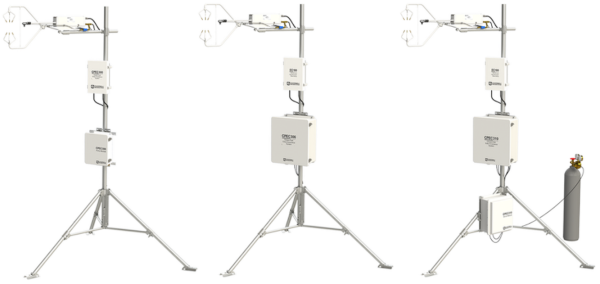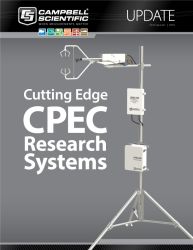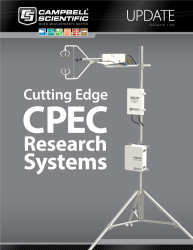
From left to right: the CPEC300, CPEC306, and CPEC310
Soon the CPEC300 series will replace the CPEC200 closed-path eddy-covariance system. The CPEC300-series systems are turn-key, closed-path eddy-covariance (EC) flux systems for long-term monitoring of atmosphere-biosphere exchanges of carbon dioxide, water vapor, heat, and momentum. Three models are offered that support different applications:
- CPEC300—A basic, entry-level, closed-path eddy-covariance flux system that is a good solution for sites with fewer sensors and a short tower
- CPEC306—A mid-level, expandable, closed-path eddy-covariance system that is a good solution for sites with many sensors and either a short or tall tower
- CPEC310—A high end, expandable, closed-path eddy-covariance system that is a good solution for sites with many sensors and either a short or tall tower, and that will use automatic zero and span
Each system typically includes an EC155 closed-path gas analyzer, CSAT3A sonic anemometer (ordered as an option), CR6 datalogger (ordered as an option), sample pump, and enclosures that house the electronics. The CPEC310 also has a valve module that provides automatic zero and span, and an optional scrub module that provides a convenient source of zero gas. Often the CDM-A116 16-channel analog input module is ordered with a CPEC306 or CPEC310 to connect additional energy-balance and meteorological sensors. The CDM-A116 fits inside the system enclosure.
The intake design and small sample cell volume of the EC155 provide excellent frequency response with low total system power (12 W typical). Furthermore, the now-available vortex intake greatly reduces maintenance and maintains frequency response compared to traditional in-line filters. Other benefits of the CPEC300-series systems include:
- Active system flow control
- Continuous operation in inclement weather
- Heated sample intake that prevents condensation
- Installation that requires minimal tools
We look forward to the improvements these systems will bring to eddy-covariance measurements.

